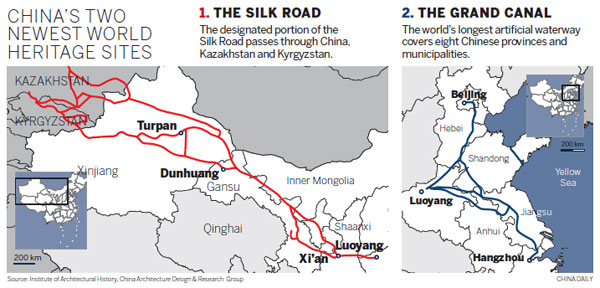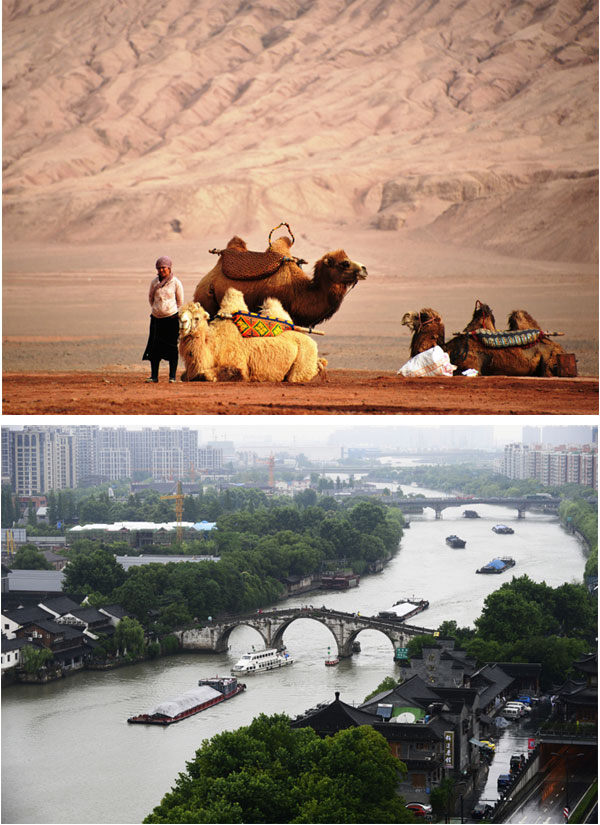Silk Road, Grand Canal recognized as world treasures
Updated: 2014-06-23 06:56
By Wang Kaihao (China Daily)
|
||||||||
Part of the Silk Road has become China's first international joint project to be recognized on the UNESCO World Heritage site list, as the ancient route between China and Europe is catching increasing attention from the international community.
China gained its 46th and 47th listings on the World Heritage Site roster, as well as its 32nd and 33rd World Cultural Heritage designations, on Sunday when the World Heritage Committee approved including parts of the Silk Road and the Grand Canal on the lists at a UNESCO conference in Doha, Qatar.
The portion of the Silk Road passes through China, Kazakhstan and Kyrgyzstan. It is one of the biggest World Cultural Heritage areas in terms of geographic distribution and is the first World Heritage site co-owned by China and other countries.
"The success of the Silk Road also gave us important experience in terms of cross-border cooperation in the field," said Tong Mingkang, deputy director of the State Administration of Cultural Heritage and the head of China's delegation to Doha.
According to Lu Qiong, deputy head of the office in charge of World Heritage Protection under the State Administration of Cultural Heritage, the steering committee of the trilateral working group for the Silk Road project held 15 meetings in China to prepare for the application. The filings had to be written in five languages, which greatly increased the workload.
In September, President Xi Jinping, in a speech in Astana, Kazakhstan, first proposed building a Silk Road economic belt to boost regional cooperation with Central Asian countries.
"Listing the Silk Road as a World Heritage will create a new belt connecting China and Central Asia for peaceful dialogue and common development," Tong added. "We will keep promoting coordination among the many sides concerned to explore a practical way to better reserve, manage and utilize the huge and dynamic cultural heritages in modern times."
UNESCO began to encourage countries along the Silk Road to join hands in bidding for World Heritage status as early as the 1990s. However, substantive work only began in 2006, due to academic disputes over which corridor was the most representative.

The current project stood out among several candidate routes in earlier evaluation by the International Council of Monuments and Sites.
Tong said China would probably submit more international requests for World Heritage status in the future.
There are 33 historical sites in the Silk Road project, with 22 in China's four provincial-level administrative regions (Shaanxi, Henan and Gansu provinces and the Xinjiang Uygur autonomous region) together with eight in Kazakhstan and three in Kyrgyzstan. The complex project includes various types of heritage, including Buddhist sites, military passes and remains of ancient cities.
The main line of this ancient route connecting the East and the West was in use from the 2nd century BC to the 16th century AD and stretched for more than 8,700 kilometers during its peak use.
The other winning candidate on Sunday, the Grand Canal, covers eight Chinese provinces and municipalities. The canal is the world's longest artificial waterway.
China has the world's second-largest number of World Heritage sites after Italy, although it only made the list for the first time in 1987, 10 years after the first session of the World Heritage Committee was held.
wangkaihao@chinadaily.com.cn
|
The ancient Silk Road, a corridor for trade and cultural exchange between Asia and Europe dating back 2,000 years, and the Grand Canal, the longest artificial waterway in the world, were added to the World Heritage list on Sunday. Jiang Xiaoming / for China Daily Li Zhong / for China Daily |

(China Daily 06/23/2014 page1)
- Long history of China's financial capital
- Shanghai increasingly favored by sci-fi filmmakers
- Maverick director steals the show
- China announces stimulus package for film industry
- Children attend First Writing ceremony at Confucius Temple
- Culture insider: 7 things you might not know about Summer Solstice

 Council of Fashion Designers of America Awards
Council of Fashion Designers of America Awards
 Fan Bingbing, first Chinese actress in Barbie Hall of Fame
Fan Bingbing, first Chinese actress in Barbie Hall of Fame
 Awarding ceremony of 2014 hito Pop Music held in Taipei
Awarding ceremony of 2014 hito Pop Music held in Taipei
 Zhao Liying's photo shoot for Children's Day
Zhao Liying's photo shoot for Children's Day
 'Taken 2' grabs movie box office crown
'Taken 2' grabs movie box office crown
 Rihanna's 'Diamonds' tops UK pop chart
Rihanna's 'Diamonds' tops UK pop chart
 Fans get look at vintage Rolling Stones
Fans get look at vintage Rolling Stones
 Celebrities attend Power of Women event
Celebrities attend Power of Women event
Most Viewed
Editor's Picks

|

|

|

|

|

|
Today's Top News
Neighboring countries urged not to stir tensions
Criticism by ex-US official dismissed
Roughshod over China's rights
Chinese tourists advised to play it safe
US mulls airstrikes in Iraq, but no clear path forward
PLA official rips Tokyo's 'historical distortions'
Developer demands edits to new Transformers film
Iran opposes US intervention in Iraq
US Weekly

|

|









